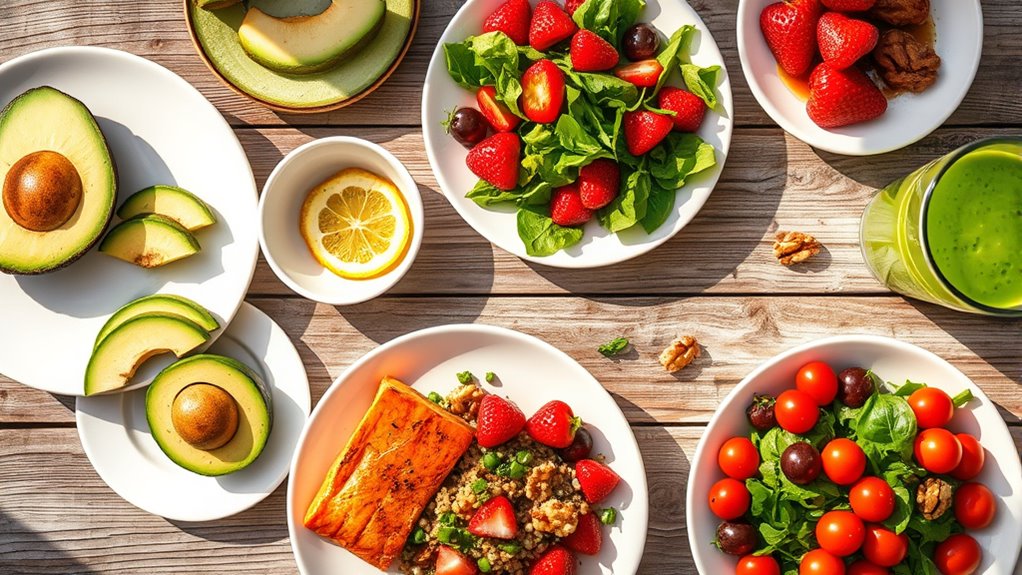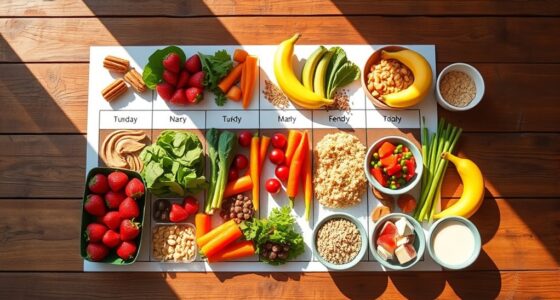A heart-healthy 7-day meal plan emphasizes whole grains, lean proteins, healthy fats, and plenty of vegetables, helping you manage cholesterol and boost your cardiovascular health. Focus on oatmeal, salmon, nuts, beans, and colorful salads seasoned with herbs and citrus, while reducing salt intake. Prepare simple, flavorful dishes that support sustainable habits. If you keep exploring, you’ll discover practical tips and tasty recipes to make your heart health journey enjoyable and effective.
Key Takeaways
- Incorporate nutrient-dense foods like whole grains, legumes, lean proteins, and colorful vegetables to support heart health.
- Include omega-3-rich seafood and healthy fats from nuts and plant oils to boost cardiovascular benefits.
- Use herbs, spices, citrus, and potassium-rich foods to flavor meals naturally and reduce sodium intake.
- Prepare meals using healthy techniques such as grilling, stir-frying, and trimming excess fats for maximum heart benefits.
- Practice mindful eating, portion control, and reflection to maintain motivation and establish lasting heart-healthy habits.
Day 1: Nourishing Breakfast and Lunch Options
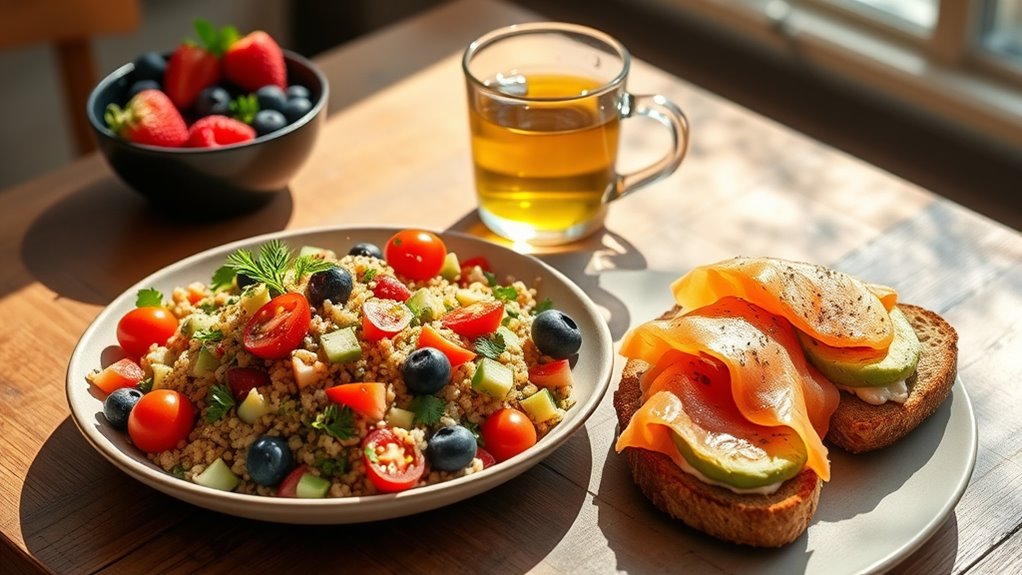
Starting your heart-healthy day with a nutritious breakfast sets the tone for good choices later. Incorporate Mediterranean flavors like fresh tomatoes, olives, and feta into your morning meal for added heart benefits. A simple way is to prepare a veggie-packed Greek yogurt bowl or whole-grain toast topped with avocado and hummus. For lunch, focus on easy meal prep tips by making Mediterranean-inspired salads with chickpeas, cucumbers, and olive oil dressing in advance. These dishes are not only rich in healthy fats and fiber but also quick to assemble. Keep portions moderate, and use herbs like oregano and basil to boost flavor without excess salt. This approach helps you stay on track, enjoy vibrant flavors, and set a heart-healthy tone for the rest of your day.
Day 2: Heart-Healthy Snacks and Dinner Ideas
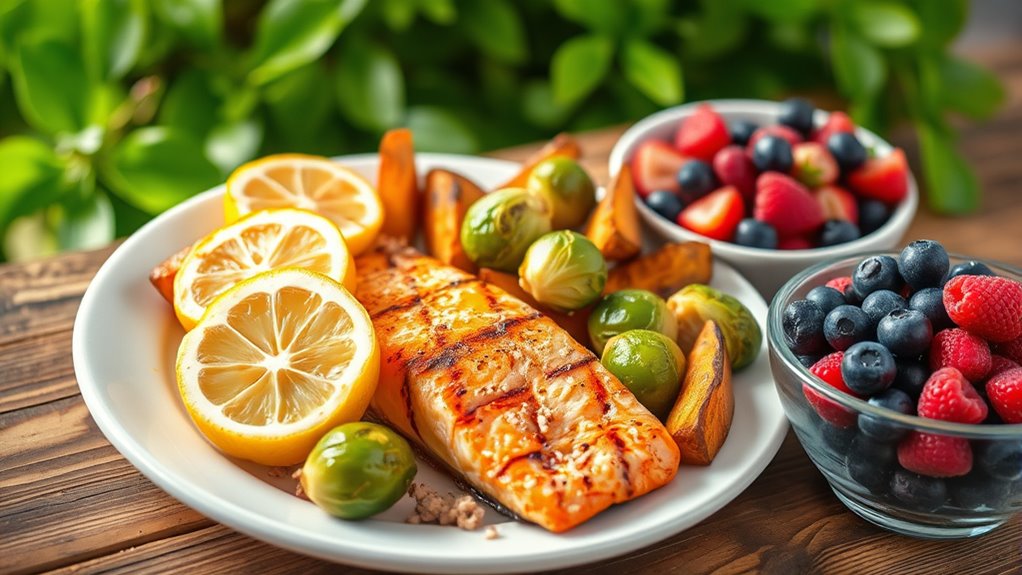
On Day 2, you’ll find tasty snack ideas like nutty options and fruit and nut mixes that keep your heart in mind. For dinner, grilled fish provides a healthy, omega-3-rich choice your body will thank you for. These simple ideas make sticking to your heart-healthy goals easy and enjoyable.
Nutty Snack Options
Nutty snacks are a delicious and nutritious way to support your heart health, especially when you choose the right options. Almond butter is a tasty alternative to processed spreads, providing healthy fats and protein that boost your heart. Spread it on whole-grain toast or add a spoonful to smoothies for extra creaminess. Trail mix is another excellent choice; opt for a mix that includes unsalted nuts, seeds, and dried fruit without added sugars. These snacks deliver fiber, antioxidants, and healthy fats that can help lower bad cholesterol levels. Keep portion sizes in check to avoid overeating, and always choose natural, minimally processed options. Incorporating these nutty snacks into your day can satisfy your cravings while supporting your overall heart health. Online scandals and infidelity exposure have shown how secrets can be uncovered, reminding us of the importance of transparency in relationships.
Fruit and Nut Mixes
Including fruit and nut mixes in your snack routine is a simple way to boost heart health. Trail mix combines crunchy nuts with dried fruits, providing a satisfying, nutrient-rich snack. Nuts like almonds, walnuts, and pistachios offer healthy fats that support your cardiovascular system, while dried fruits such as cranberries, apricots, or raisins add natural sweetness and fiber. Opt for unsalted or lightly salted varieties to reduce sodium intake. Keep portions moderate to avoid excess calories, and choose mixes with minimal added sugars or preservatives. This combination helps lower bad cholesterol and keeps your energy steady throughout the day. Incorporating trail mix into your diet is convenient and versatile—enjoy it on-the-go, at work, or as a quick evening snack. Proper portioning is important to prevent overeating and maximize health benefits.
Grilled Fish Dinners
Grilled fish dinners are a delicious and heart-healthy way to incorporate more omega-3 fatty acids into your diet. To guarantee perfect seafood prep, follow these steps:
- Select fresh fish like salmon or mackerel for maximum health benefits.
- Use a simple fish seasoning, such as lemon juice, garlic, and herbs, to enhance flavor without excess salt.
- Preheat your grill to medium-high heat for even cooking.
- Grill the fish for 4-6 minutes per side, depending on thickness, until opaque and flaky.
- Remember to oil the grill grates lightly to prevent sticking. These tips help you prepare flavorful, nutritious grilled fish dinners that support heart health. Additionally, understanding the importance of trust in relationships can help you foster healthier connections beyond your diet.
Day 3: Incorporating Whole Grains and Legumes
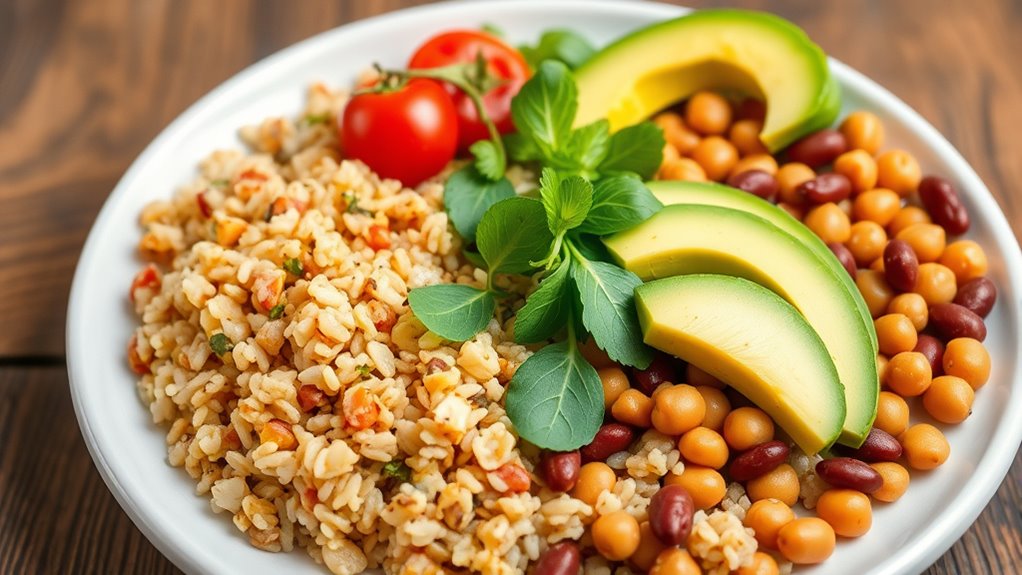
Adding whole grains and legumes to your meals is an effective way to boost heart health. Focus on smart grain pairing by combining brown rice, quinoa, or oats with vegetables and lean proteins. These combinations help improve nutrient absorption and add variety to your diet. Incorporate legumes like beans, lentils, or chickpeas, which are rich in fiber and antioxidants. When selecting legumes, consider supporting legume cultivation by choosing locally grown or organic options, ensuring fresh and sustainable ingredients. Prepare salads, soups, or grain bowls that feature these ingredients for a heart-healthy boost. Regularly including whole grains and legumes can lower bad cholesterol and reduce your risk of cardiovascular disease. Keep experimenting with different pairings to keep your meals both delicious and nourishing.
Day 4: Lean Proteins and Vegetable-Packed Meals

Have you ever wondered how to make your meals both satisfying and heart-healthy? Day 4 focuses on lean proteins and vegetable-packed meals. To elevate your dishes, consider these options:
- Incorporate plant-based proteins like tofu, tempeh, or legumes for a heart-smart alternative.
- Prepare vegetable stir fries using colorful vegetables and minimal oil for flavor and fiber.
- Use lean meats such as chicken or turkey, trimming excess fat before cooking.
- Experiment with seafood like salmon or trout, rich in omega-3 fatty acids, to support heart health.
- Choose eco-friendly and safe ingredients, such as organic vegetables and sustainably sourced seafood, to ensure a healthy and sustainable meal.
Day 5: Plant-Based Meals and Omega-3 Boosters
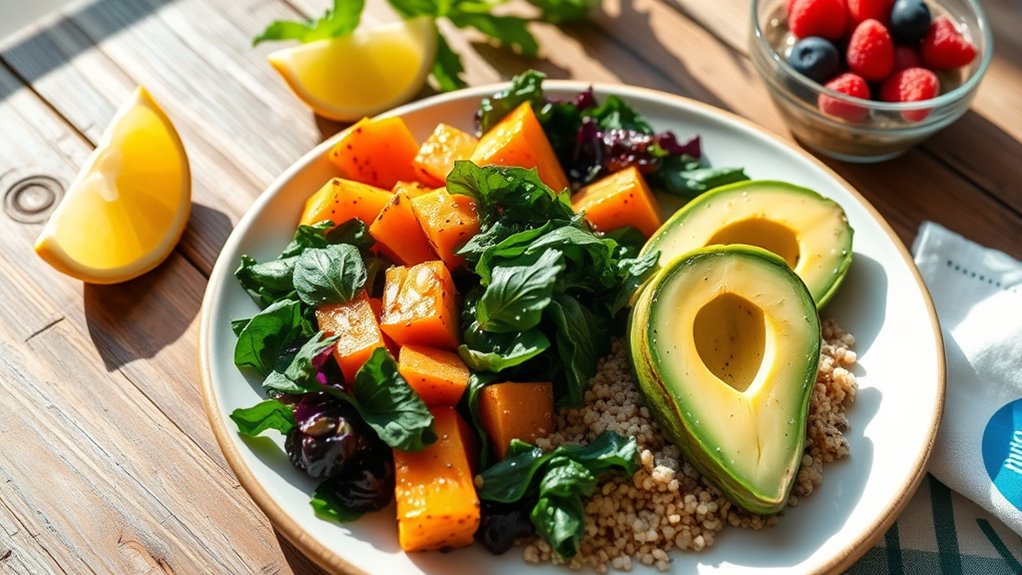
Since plant-based meals are naturally rich in fiber and nutrients, incorporating more of these options can considerably boost your heart health. Focus on diverse seafood varieties like salmon, mackerel, and sardines, which provide essential omega-3 fatty acids known for reducing inflammation and lowering triglycerides. Use plant-based oils such as flaxseed, chia seed, and walnut oil to add healthy fats and omega-3s to your dishes. These oils not only enhance flavor but also support cardiovascular health. Incorporate hearty salads, grain bowls, or stir-fries with these ingredients to maximize omega-3 intake. By choosing plant-based oils and seafood varieties, you fuel your body with heart-healthy fats that promote better circulation and reduce the risk of heart disease. Additionally, exploring Hyundai Tuning options can inspire you to customize your vehicle for better performance and efficiency.
Day 6: Low-Sodium and Flavorful Dishes

You can make your meals flavorful without adding extra salt by using herbs and spices. Natural alternatives like lemon juice or vinegar enhance taste while keeping sodium in check. Try these tips to enjoy tasty, heart-healthy dishes that are low in sodium. Incorporating best anime movies into your relaxation time can also help reduce stress and promote overall heart health.
Herbs and Spices Boost Flavor
Herbs and spices are powerful tools for enhancing flavor without relying on salt, making them essential for low-sodium dishes. By mastering herb pairing and spice blending, you can create vibrant, flavorful meals that satisfy your palate and support heart health. Consider these tips:
- Combine basil, oregano, and thyme for Mediterranean-inspired dishes.
- Use cumin, coriander, and paprika for warm, smoky flavors.
- Mix parsley, dill, and chives to brighten salads and fish dishes.
- Experiment with cinnamon and nutmeg in sweet or savory recipes.
Additionally, understanding the flavor-enhancing properties of herbs and spices can help you craft well-balanced and satisfying meals with less salt. These techniques allow you to elevate your cooking, adding depth and complexity without extra sodium. When you thoughtfully select and combine herbs and spices, you turn simple ingredients into sophisticated, heart-healthy meals that delight the senses.
Natural Alternatives to Salt
Herbs and spices can elevate flavor without adding salt, but exploring natural alternatives can further enhance your dishes’ taste while keeping sodium levels low. Herbal seasonings like basil, oregano, thyme, and rosemary add depth without sodium. Citrus juices, such as lemon or lime, brighten flavors naturally. Incorporate potassium-rich foods like bananas, sweet potatoes, spinach, and beans to help balance sodium intake and support heart health. Apple cider vinegar and garlic also serve as flavorful substitutes for salt, providing zest and aroma. Fresh herbs not only add vibrant flavor but also contribute antioxidants beneficial to your overall health. Additionally, understanding the role of potassium in maintaining heart health can guide you in selecting heart-smart ingredients. By experimenting with these natural alternatives, you can create delicious, heart-healthy meals that satisfy your palate without relying on excessive salt.
Tips for Reducing Sodium
Reducing sodium in your meals is essential for heart health, but it doesn’t mean sacrificing flavor. To lower your sodium intake, try these tips:
- Use herbs, spices, or citrus to enhance flavor without salt.
- Opt for fresh ingredients instead of processed foods, which often contain hidden salt.
- Experiment with salt alternatives like potassium chloride, but check with your doctor first.
- Read labels carefully to choose low-sodium or no-salt-added products.
Day 7: Wholesome Wrap-Up and Reflection on Your Progress

As you reach Day 7 of your heart-healthy meal plan, it’s important to take a moment to reflect on your journey so far. Practicing mindful eating has helped you become more aware of portion sizes and food choices, strengthening your emotional resilience. By paying attention to how your body feels and savoring each bite, you’ve built a stronger connection to your health goals. This reflection allows you to recognize your progress, celebrate small victories, and identify areas for improvement. Remember, this process isn’t just about the food; it’s about cultivating a healthier relationship with eating and yourself. Incorporating mindful eating techniques can further enhance your overall well-being as you continue on this path. Keep these habits in mind as you move forward, confident in the positive changes you’ve made.
Frequently Asked Questions
How Can I Customize Meals for Specific Dietary Restrictions?
When customizing meals for specific dietary restrictions, you have plenty of options for meal substitution to meet your needs. Focus on maintaining dietary flexibility by swapping ingredients that fit your restrictions, like plant-based proteins instead of meat or gluten-free grains. Always read labels carefully, and experiment with herbs and spices to enhance flavors without adding unwanted ingredients. This approach helps you enjoy delicious, personalized meals that support your health goals.
What Are Affordable Options for Heart-Healthy Ingredients?
You want to make heart-healthy choices without breaking the bank. Look for low-cost produce like carrots, spinach, and bananas—they’re nutritious and budget-friendly. Incorporate affordable protein sources such as beans, lentils, and canned tuna, which provide essential nutrients without high costs. By choosing these options, you can enjoy a balanced diet, save money, and support your heart health, all while staying within your budget.
How Do I Handle Food Allergies in Meal Planning?
When handling food allergies in meal planning, you should focus on allergy-friendly recipes and careful label reading tips. Always check ingredient labels for potential allergens, and look for allergy-friendly alternatives. Prepare meals with safe ingredients, and communicate your allergies clearly when dining out. This approach helps you avoid allergic reactions and enjoy nutritious, heart-healthy meals without worry. Staying vigilant guarantees your diet remains safe, tasty, and aligned with your health needs.
Can These Meals Be Prepared in Advance for Busy Schedules?
You can definitely prepare these meals in advance for busy schedules. Use meal prep strategies like batch cooking and portioning to save time. Store your meals in airtight containers and follow storage tips like keeping perishable items refrigerated or frozen to guarantee freshness. This way, you can enjoy healthy, heart-friendly meals without the stress of daily cooking, making it easier to stay on track with your health goals.
What Are Some Tips to Stay Motivated on a Heart-Healthy Diet?
To stay motivated on a heart-healthy diet, focus on mindset strategies like positive self-talk and celebrating small wins. Set clear, achievable goals to keep yourself accountable and track progress. Remind yourself of the benefits, such as better energy and long-term health. Keep your environment supportive by planning meals ahead and seeking encouragement from friends or family. These tactics help you stay committed and make healthy choices easier.
Conclusion
Think of this week as planting a garden inside you. Each healthy meal is a seed, nurturing your heart’s strength and resilience. As you tend to this garden daily, watch your vitality bloom and fears wither. Remember, consistent care transforms tiny seeds into a lush, thriving sanctuary. Keep nourishing yourself with these choices, and soon, your heart will flourish like a vibrant, unstoppable garden—proof that small steps grow into lifelong wellness.
